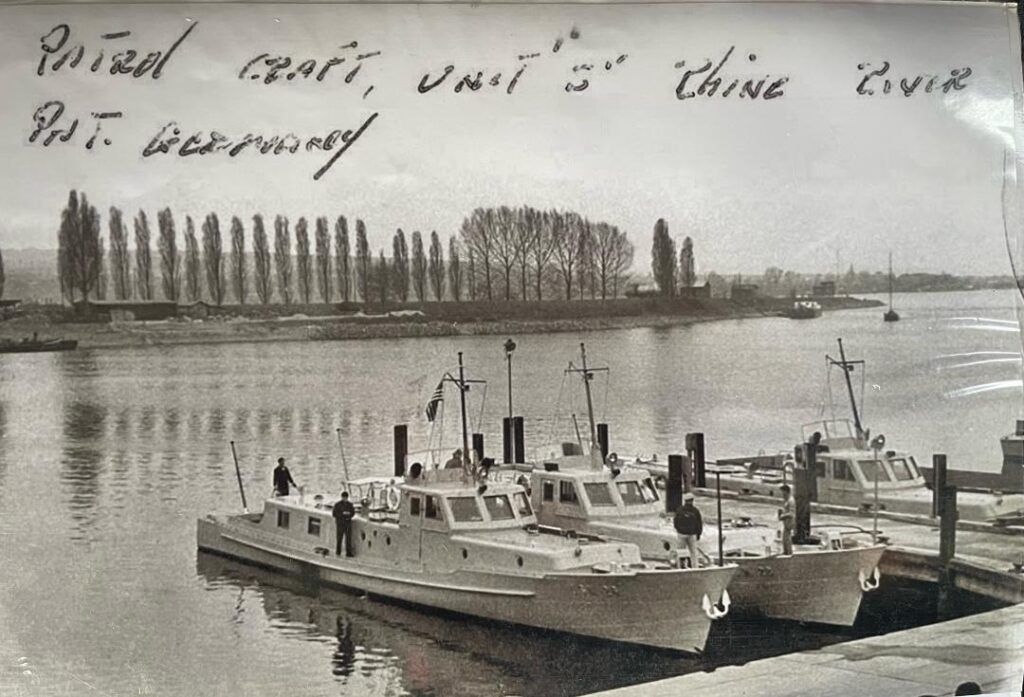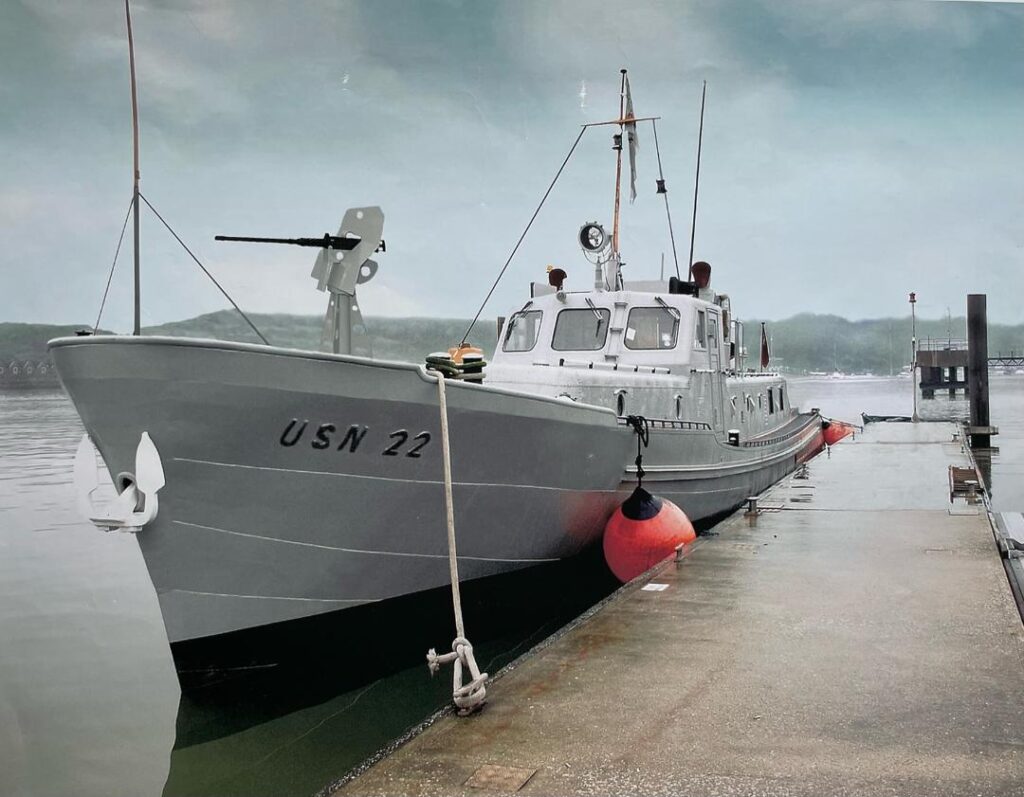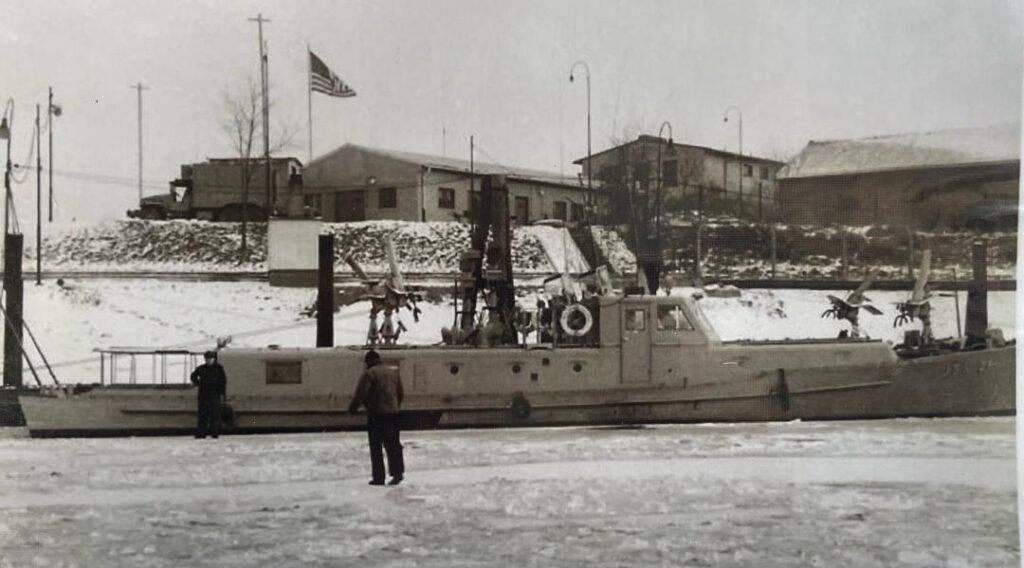So just how does a German built, American naval boat end up in a sleepy Kent village?
Something that most of us would believe has gone forever. Rusted away or beyond repair brought back to life and its former glory.

We all know the passion that people have when it comes to restoring military vehicles and the like. The hours poured in, the money spent, and the uncertain future of their labours.
Be it a tank, a jeep, an aircraft, or in this case a United States Navy Cold War patrol boat.
When I was invited along to see the USN P22 Rhine patrol boat, I simply jumped at the chance. To be honest, I would have swam!
 USN P22 Leaves Ramsgate Harbour in Kent on its way to France. An impressive site.
USN P22 Leaves Ramsgate Harbour in Kent on its way to France. An impressive site.
As WW2 neared its climax in Europe there was one major obstacle still to overcome. The mighty Rhine. Germany’s lifeline. The assault crossing of the Rhine river was called Operation Plunder.
It started in earnest on March 23rd, 1945. The bombing strategy was to be a hugely challenging endeavor, as were the logistics once the territory had been taken.
Even before the war had ended in 1945, the Cold War was in full swing. America, Britain, and France were, quite literally looking at one another across the river with caution and some distrust. This was despite the common enemy being the Russians who were actually miles away in the East.
![]() A familiar face over one of the bunks on the USN P22 Patrol Boat.
A familiar face over one of the bunks on the USN P22 Patrol Boat.
At the start of the Cold War the Allies had over 300 miles of the Rhine to patrol. This was divided into French, British and American sectors. The US had the lions share of the river however. It was no simple task. Special boats, such as P22 were built for this specific job.
P22 was one of 17 purpose-built Type 21 patrol vessels built in 1952. They were paid for by the United States but were built in West Germany at the Hizzler Ship Yard . The main purpose of the vessel was quite simply to patrol the Rhine.
She was fitted with two twin diesel engines which propelled the steel hulled boat effortlessly across the water. She did this at an amazing 21 knots (26mph).
Her sleek design was cutting edge at the time and she proved to be a popular craft. Even with a crew of 6 sailors the 78 foot craft was relatively spacious. The boat included a small galley, a toilet, a captain’s quarters and a mess area.
 Patrol craft. Unit ‘S’ Rhine River Patrol Germany. USN P22 is in the centre
Patrol craft. Unit ‘S’ Rhine River Patrol Germany. USN P22 is in the centre
Even in 1952, the Rhine was still full of sunken ships and boats of all shapes and sizes. Crashed aircraft occasionally resurfaced on strong tides and even tanks were seen close to the shore!
Many of the bridges were still being rebuilt and many of the villages that had lined the river had been destroyed by Allied bombing. In some cases they had clogged the waterways.
Navigating the Rhine was therefore a somewhat complex process. One of the roles of P22 was to act as a pilot for other ships. If you’ve ever been to the Rhine in Germany, you would soon discover that it is basically an aquatic freeway.
As so many people had been displaced during the Second World War, even in the 1950s people were still moving around, with some trying to find their loved ones while others wanted to start a new life entirely.
 Sleek and and an advanced design. The P22 was popular among her crew.
Sleek and and an advanced design. The P22 was popular among her crew.
As a consequence, a lot of these displaced people made use of the Rhine as a means of getting around.
Another product of post-war Germany was the black market. Food was still rationed as was clothing and this was often smuggled up and down the river. P22 and its crew had the job of stopping suspicious-looking boats.
Another by-product of World War 2 was of course firearms. Again, these were often sold with ammunition for various reasons and again smuggled by boat up and down the river.
This was a serving U.S. Navy vessel and it had to be armed accordingly. P22 was equipped with three heavy machine guns. It had an impressive twin .50 cal upfront and a single .50 cal at the rear.
The crew were armed with .45 pistols and M1 carbines. The reason the M1 carbine was used aboard the vessel was because it was smaller compared to the Garand. It could be wielded out of the tight doors and hatches of the craft without fear of being snagged.
Although the guns were never fired in anger there was an incident when a pig was spotted on the river bank. The idea of fresh pork proved too much . A shot from one of the .50 cals soon dispatched the said pig.
 A Remarkable photo of P22 ‘Stuck in port’ as the Rhine froze over.
A Remarkable photo of P22 ‘Stuck in port’ as the Rhine froze over.
To make the scene even more bizarre the pig was hauled upon a floating pontoon and a fire lit underneath. One can only assume on a metal oil drum or similar –
as if that wasn’t odd enough – that the ingenious crew continued to patrol the river! All the while towing the pontoon and pig whilst it cooked along with them. No record of how it tasted was kept!
When not patrolling, P22 helped resupply food to the West Germans often in remote areas. This was particularly helpful during the floods and in the winter months. It was a lifeline to many West Germans.
As the Cold War threat slowly thawed the US Navy eventually gave P22 to the West German Army in 1958. It continued as a patrol boat for the next 10 years.
It wasn’t until the 1960s, that the Rhine was declared fully void of obstacles and was again open for free navigation to shipping.
In 1968, the P22 (now re-named) was sold again, this time to an oil company. The boat was used as a rescue vessel in the Scottish oilfields. After the craft was deemed unsuitable for this role, it was again sold and moved to Chatham in Kent. It was here she became a houseboat.
 After a repaint P22 was featured in Christopher Nolan’s WW2 epic Dunkirk.
After a repaint P22 was featured in Christopher Nolan’s WW2 epic Dunkirk.
After another turn of fate, she was purchased by Barry Field in 2014. Barry wanted to restore her back to her original livery and in some ways, her original role. P22 was transported back to the 1950s Cold War.
In 2017 the P22 was brought to Sandwich in Kent, where she now berths, fully refurbished and restored.
She has a dedicated crew of volunteers who look after her and continue flying the flag in honour and memory of all of those not only from America but also in Germany who worked on or relied upon this small but powerful craft.
In 2019 P22 participated in the 75th D-Day commemoration events. Even as a boat of the Cold War her historical importance hasn’t escaped the French who invite her back time and time again.
 The dedicated volunteer crew of USN P22 hope to get extra funding to keep the boat active. Owner, Barry Filed sits at centre.
The dedicated volunteer crew of USN P22 hope to get extra funding to keep the boat active. Owner, Barry Filed sits at centre.
The P22 has even made the movies! She featured in the 2017 blockbuster DUNKIRK staring Harry Styles, Kenneth Branagh and Tom Hardy.
A New coat of paint and she became the Admiral of the Fleet’s launch in Christopher Nolan’s blockbuster.
With support from Sandwich Town Council, the USN P22 became a charitable trust in January 2018 and continues to raise funds for its upkeep. Sadly and somewhat remarkably, because the boat is American they are not entitled to lottery funding.
 Here’s hoping to many more sunrises for P22 and its volunteer crew.
Here’s hoping to many more sunrises for P22 and its volunteer crew.
They rely on private donations to keep her afloat and looking spick and span. This, despite the P22 being the only American boat left of its kind anywhere.
To find out more about this piece of history, ask questions or even donate see their link below.
The volunteers of the USN P22 patrol boat have even contacted the American Embassy in London.
Although the embassy have responded positively they still await any offer of financial help to keep this piece of American history afloat. We watch this space with our fingers crossed.





